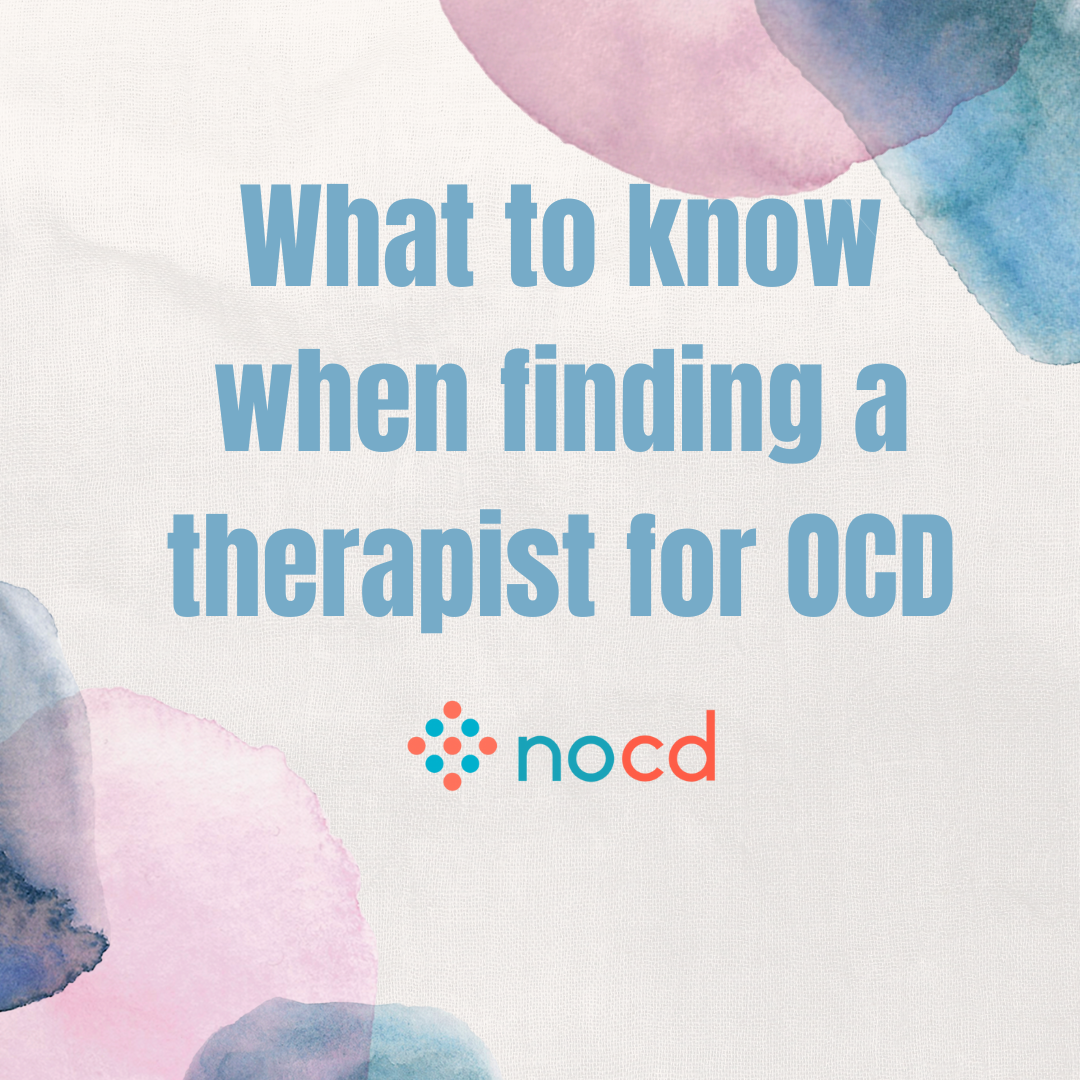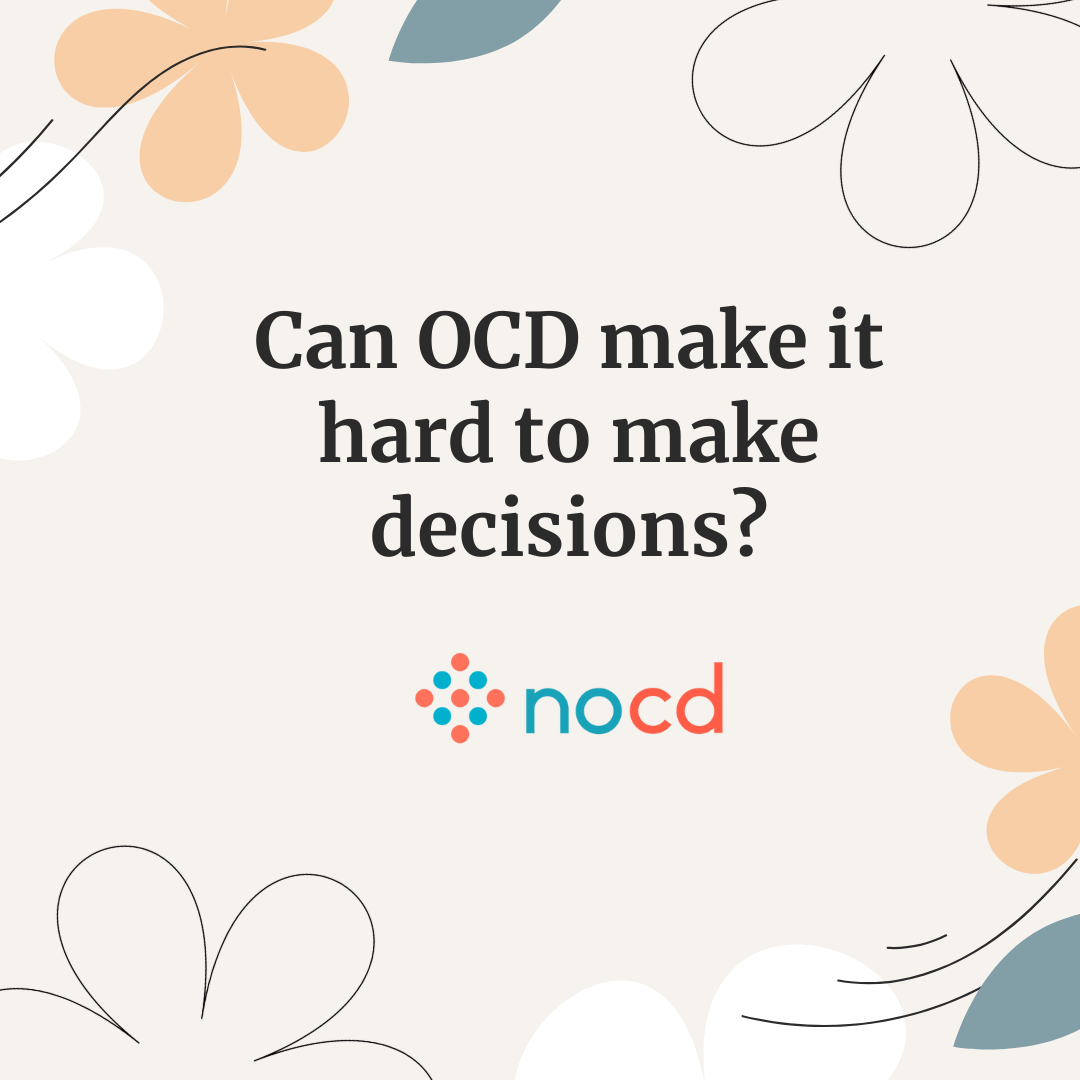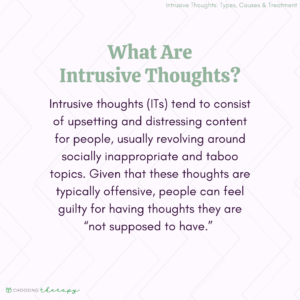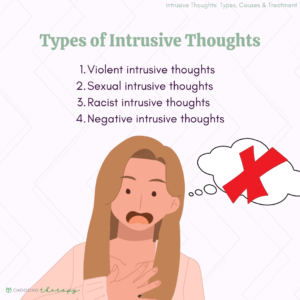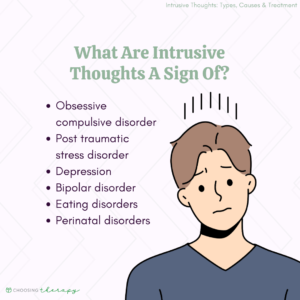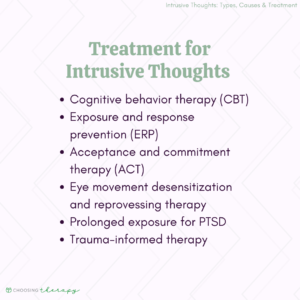Most thoughts are transient and may go unnoticed. Those considered intrusive thoughts call more attention because they have content that causes people to feel bad about themselves for having them. This concern can lead to obsessive thoughts as one tries to find meaning behind them and process the feelings of disgust for having such thoughts.
Intrusive Thoughts Are Often A Sign Of OCD
Many people with intrusive thoughts also struggle with misdiagnosed OCD. The first step to getting help is an accurate clinical assessment and diagnosis. NOCD’s therapists will provide a comprehensive assessment of your experience. If they find that you do not meet the criteria for OCD, they will still help assist you in identifying what you may be experiencing. Get Started With A Free 15 Minute Call
What Are Intrusive Thoughts?
Intrusive thoughts (ITs) tend to consist of upsetting and distressing content for people, usually revolving around socially inappropriate and taboo topics. Given that these thoughts are typically offensive, people can feel guilty for having thoughts they are “not supposed to have.”
Despite being private, the intensity of ITs can lead people to feel that others can read their minds, only leading to additional complications in their ability to interact with others. A key component of ITs is that the more someone tries not to have them, the more they will increase.
When people consider ITs, they may confuse them with ruminating thoughts that lack the intrusive nature of ITs. Rumination includes a continuous mental effort to go over worries, trying to figure something out, or becoming fixated on mistakes that have been made. They are typically negative but not considered intrusive, as the person has control over stopping ruminating thoughts.
Are Intrusive Thoughts Normal?
Researchers who conducted an international study of college students found that 94% reported having had ITs.1 So, while we can say that ITs are normal, there is a distinction between more common and benign ITs and more problematic recurring ones. Unhealthy ITs can cause an individuals to fear their thoughts as they ruminate or obsess over images, words, or phrases that worry a person into thinking they want to act upon them. This uncommon fear result in one avoiding people, situations, literature, or media that may include the subject of their thoughts. People with problematic intrusive thoughts may become disconnected from social events and isolated, resulting in depression.
Types of Intrusive Thoughts
As stated, the content of many ITs tends to be socially taboo. These may include thoughts about harming someone, “perverted” sexual acts, or racist words. Fears around safety, potential catastrophes, fear of judgment by God, or existential anxieties may bring about other ITs.
Common Types of ITs include:
Violent Intrusive Thoughts
A typical example of ITs includes someone in a bad mood who may covertly wish harm on the person that is bothering them, then feel guilty afterward. Violent thoughts can become heightened when anger or negative moods are triggered. These thoughts become intrusive when the individual can’t block them and fears that one might act on them. These can be especially impactful on a person’s daily ability to interact with others as they do not want to harm others.
Some examples of violent ITs include:
- Persistent thoughts of self-harm
- Suicidal ideation
- Homicidal thoughts
- Cursing someone
- Impulsively pushing someone off a bridge
- Stabbing partner while cooking
- Fear of blurting out obscenities
- Fear of acting on impulsive destructive urges
Sexual Intrusive Thoughts
Sexual intrusive thoughts are different than sexual fantasies in that ITs are experienced as unwanted, distasteful, objectionable, and alarming. People with intrusive sexual thoughts might avoid being sexually active or reading and watching material that has sexual content. Sexual fantasies have a wide range of content but are experienced as pleasurable and exciting, at least at the moment. Some people may feel guilty for having them, but the feeling passes after a few moments, whereas intrusive thoughts are recurrent and constant.
Examples of sexually intrusive thoughts include:
- Persistent thoughts of engaging in sexual acts with strangers or children
- Violent images that interfere with focus and functioning
- Sadomasochistic images
- Incest
- Rape
Racist Intrusive Thoughts
Even when we may be accustomed to environments with lots of racial or ethnic diversity, our instincts may cause us to fear those who are different– for example, someone’s outer appearance may trigger unacceptable thoughts toward that person. As such, it is common that this fear may provoke mental racial slurs that are typically objectionable and may provoke self-disgust.
Negative Intrusive Thoughts
If we pay attention to our self-talk, we may notice how critical or judgmental we are toward ourselves, especially if we feel insecure, depressed, or have low self-esteem. We may experience negative self-talk if we have an awkward or unsuccessful interpersonal interaction or do not meet academic, work, or family expectations. Furthermore, one may have cognitive distortions that tend to have a negative bias for why or how things happen rather than seeing things objectively.
Examples of negative intrusive thoughts are:
- Thinking your loved ones would be better off without you
- Wanting to quit your job because you’re not good enough
- Feeling disappointed in the way the world works – existential angst
- Feeling like a failure
- Being negatively judged by others
- Thoughts of cheating on your partner
Treatment For OCD NOCD: Online OCD Treatment Covered By Insurance – Regain your life from OCD. Do live video sessions with a licensed therapist specialized in treating OCD. Treatment from NOCD is covered by most major insurance plans. Learn how you can use your insurance benefits. Visit NOCD Talkiatry: Is OCD Medication Right For You? Speak with A Doctor – Talkiatry can match you with a psychiatrist who takes your insurance and is accepting new patients. They’re in-network with major insurers and offer medication management with supportive therapy. Free Assessment
What Causes Intrusive Thoughts?
ITs can be interconnected by mood and cognition, and are caused by various environmental and biological factors. Some of these are hard-wired in the brain, while others result from distressing external events. For example, being a trauma or abuse victim can cause ITs like flashbacks, revenge thoughts, or self-blaming thoughts.
Some environmental and biological causes of intrusive thoughts include:
- Decreased flow of the neurotransmitter serotonin
- Stress and anxiety
- Hormonal imbalances
- Underlying mental health issues or trauma
- Negative emotions such as anger, jealousy, guilt, shame
- Uncertainty about the future
- Morbid/death-related thoughts
- Somber or solemn occasions such as places of worship, funerals, etc.
What Are Intrusive Thoughts A Sign Of?
Recurrent ITs may be a sign of problems that go beyond immediate environmental triggers or biological imbalances. ITs can be a sign of a more complex or severe mental health disorder that may need additional treatment and coping mechanisms to address.
Mental health disorders that may have intrusive thoughts as a symptom include:
Obsessive Compulsive Disorder
Obsessive-compulsive disorder (OCD) is a neurobiological disorder that signals the brain that something feels wrong, harmful, or “not right.” Since it resides in the prefrontal cortex, which is considered the moral center of the brain, the content of obsessions typically consists of taboo themes, feelings of threat, and fear of causing harm.
A public survey asked people what kinds of ITs they had. Interestingly, the list was the same as ITs that become obsessions for people with OCD. Common ITs obsessions occur in about 28-50% of the population.2,3
OCD subtypes possessing common intrusive thoughts as OCD symptoms include:
- Scrupulosity OCD: Scrupulosity OCD leads individuals to have inappropriate or blasphemous thoughts in places of worship or after seeing iconic religious symbols.
- Existential OCD: Existential OCD includes obsessive thoughts over existential anxiety regarding the meaning of life or one’s purpose. Outside of OCD, existential ITs may lead to an existential crisis.
- Contamination OCD: This type of OCD occurs when someone worries about getting sick or getting others sick from spreading germs.
Post Traumatic Stress Disorder
Post traumatic stress disorder (PTSD) is the result of having experienced or witnessed a life-threatening event such as war, natural disasters, or personal harm. Not everyone who has experienced a traumatic event will develop PTSD. However, those who have been diagnosed may experience PTSD intrusive thoughts, such as PTSD flashbacks, which are images of their traumatic event. Some other ITs of PTSD include suicidal ideation and revenge fantasies towards the person who caused them harm.
Depression
Depression is a neurobiological negative mood state. Depressive symptoms can include low energy, apathy, loss of or increased appetite, guilt, irritability, and loss of interest in social or leisure activities. People with depression often have ITs that consist of suicidal ideation, self-harm, angry thoughts about themselves or the world, or violent thoughts about harming someone with whom they are angry.
Some examples of depressive intrusive thoughts are:
- “I wish I were dead”
- “People will be better off without me”
- “I can’t do anything right”
- “I have nothing to offer”
- “People are nice to me because they feel sorry for me”
- “I might as well jump off a bridge since there’s no point in living”
- “I’d like to get back at that person who embarrassed me in front of everyone”
Bipolar Disorder
Bipolar disorder, formerly known as manic depression, is characterized by severe mood swings. When people are in a state of mania, they experience euphoria and grandiosity. They also have impulsive urges to perform extreme, even criminal, behaviors like stealing or destroying property.
Examples of ITs in a manic episode are:
- “I bet I could break into that house and rob it!”
- “No one is going to get in my
Eating Disorders
Eating disorders can reflect an obsessive need for control in anorexia, a loss of control in binge eating, or purging in bulimia. In anorexia, sufferers have a distorted body image and never feel thin enough, despite what they see on the scale or the BMI index. People who binge and purge do so to self-soothe when they think their emotions are out of control.
Perfectionism and the need for control are common traits in OCD & eating disorders. Intrusive thoughts often center around self-criticism, inadequacy, and the need to please others.
Intrusive thoughts from eating disorders might involve:
- Self-harming thoughts
- Self-punishment for imperfections or mistakes
- Never being good enough
- Shame of gluttony
Perinatal Disorders
Peripartum depression (formerly called postpartum depression) occurs during pregnancy or after a baby is born. An estimated 6.5% to 20% of women experience peripartum depression.5 Men can also experience hormonal changes during their partners’ pregnancies, with an estimated 4% of fathers experiencing postpartum depression in the first year after their child’s birth.6,7
Common themes of peripartum intrusive thoughts include:
- “What if my baby gets sick or dies?”
- “I should keep my house sterile enough, so I won’t cause the baby to get sick.”
- “I should check to make sure everything is safe in the house.”
- “If another person holds the baby, they will give them germs.”
- “What if I put the baby down, and it suffocates?”
- “I should check to see if the baby is breathing to avoid sudden infant death syndrome.”
- What happens if I end up dropping the baby?”
- “I don’t think I am bonding enough with my baby.”
Becoming a parent is a life-changing event, and irrational thinking and irritability during this phase can reach the point of functional impairment as postpartum OCD. These intrusive thoughts stem from worrying one might accidentally or unconsciously want to harm their baby. They may also have ITs about not nurturing their baby’s soul or adequately performing religious practices to ensure the baby is free from sin and in good moral standing.
Postpartum OCD intrusive thoughts may consist of:
- “What if I fall down the stairs with my baby in my arms?
- “What if I poison the baby when I feed him?
- “What if I stab the baby while I’m cooking?
- “I can picture myself driving off the road with my baby in the car.”
- “I’m having sexual thoughts when I change the baby’s diaper.”
- “What if I don’t love my baby?”
Any ambivalence about having children or realizing the sacrifice of independence to provide for the needs of a baby who is fully dependent on the parent can create peripartum depression.
Typical intrusive thoughts for those suffering from PPDA include:
- How their role in life will change
- Worries about being incompetent
- Having a heightened level of responsibility
- Being a good parent and doing things “right”
- Micromanaging diet after weight gain
How Are Intrusive Thoughts Diagnosed?
Intrusive thoughts are diagnosed by medical or mental health professionals familiar with anxiety disorders, PTSD, or assessing domestic or relationship abuse. A diagnostic examination typically includes interviews or psychological assessment tools. A doctor might also consider someone’s family history of psychiatric problems and ask questions related to disorders in which ITs commonly occur.
Some individuals are afraid to disclose their ITs out of fear their thoughts will be misunderstood as intent and potentially reported to the police or result in hospitalization. Clinicians familiar with associated disorders can assess if the thoughts are ego-syntonic (part of the person’s core beliefs/identity) or are ego-dystonic (alien to the person’s beliefs/identity).
How much do you know about OCD? Take This 11-Question OCD Quiz From NOCD. If you or a loved one are struggling with OCD, NOCD provides convenient, affordable, and effective OCD treatment covered by most major insurance plans.
Treatment for Intrusive Thoughts
There are several psychological options for treating ITs, including medication which may be prescribed if a person’s ITs impact functioning. Selective serotonin reuptake inhibitors (SSRIs), commonly prescribed for OCD and depression, are effective in taking the edge off of ITs.
Therapy options for intrusive thoughts may include:
- Cognitive behavior therapy (CBT): CBT challenges distorted beliefs and thought processes.
- Exposure and response prevention (ERP): ERP encourages clients to purposeful think of their ITs without trying to reduce discomfort or distress. This allows for the thought to run its course
- Acceptance and commitment therapy (ACT): ACT focuses on helping people to accept having their ITs and making the commitment to function normally by taking them along for the ride
- Eye movement desensitization and reprocessing therapy (EMDR): EMDR for PTSD works to help clients reduce emotional distress and develop cognitive insights.
- Prolonged exposure: Prolonged exposure sessions usually consist of 60-90 minute sessions during which the person faces and stays with their trauma triggers until the distress begins to taper off. In turn, they learn that the trauma-related memories and cues are not dangerous and do not need to be avoided.
- Trauma-informed therapy: Trauma-informed therapy addresses thought processes that help a person acknowledge the reality of their trauma. They can then learn how to break their dysfunctional patterns of interpersonal dynamics and improve coping abilities
What to Do About Intrusive Thoughts
The worst way to handle ITs is trying not to have them. Researchers proved this notion in the “White Bear” experiment, where participants were instructed to talk while not thinking of a white bear. Despite the effort of not having the thought, paradoxically, the notion instead leads to having it more.8 Instead of trying to avoid having intrusive thoughts, focus on learning strategies that stop intrusive thoughts from interfering with your daily functioning.
Some things that can make intrusive thoughts worse include:
- Acting on or engaging with intrusive thoughts.
- Questioning why you have them in the first place.
- Trying to look for the meaning behind them.
- Trying to suppress them so that they don’t rebound.
Some additional coping mechanisms that can help eliminate anxiety and physiological responses to intrusive thoughts include:
- Journaling: Writing in a journal for your mental health is a more active cognitive processing method than thinking and reading. One helpful technique is to write down intrusive words and phrases or describe the images repeatedly until your brain gets bored of them.
- Diaphragmatic breathing (DB): Breathwork activates the relaxation response of the parasympathetic (rest and digest) nervous system and counteracts the fear response.
- Self-soothing techniques: These include activities that can reduce stress, such as taking a bath, taking a mindful walk, or listening to relaxing music
- Engaging in creative activities: Using hands as tools for making things is mindful and soothing, especially if there is repetitive behavior involved.
- Talking to people who love you: Calling someone you love can help you get out of your head.
- Finding time to laugh: Humor is another way to disarm the emotions and anxiety related to the impact of ITs. Humor sets off “feel good” endorphins that distract the person from these thoughts.
- Practicing self-compassion: Self-compassion fosters having a better relationship with yourself by being kind, supportive, and understanding of your challenges with ITs.
- Meditating and mindfulness: These practices help people focus on the immediate moment, in turn developing the ability to be more focused, observing, and objective of the external environment
Final Thoughts
Humans will have intrusive thoughts until we no longer have neurobiological fear levels that drive them. We shouldn’t judge ourselves for having them, but accept them as part of our human experience. We can treat ourselves with kindness and self-compassion and even find humor in having them. If the IT persists, seek help from a mental health professional.
To help our readers take the next step in their mental health journey, Choosing Therapy has partnered with leaders in mental health and wellness. Choosing Therapy is compensated for marketing by the companies included below. OCD Therapy NOCD: Effective, Affordable, & Convenient OCD Therapy Do live, face-to-face video sessions with a therapist who specializes in treating OCD and get 24/7 support between sessions. NOCD is covered by many insurance plans and is available nationwide. Visit NOCD Virtual Psychiatry Talkiatry Get help from a real doctor who takes your insurance. Talkiatry offers medication management and online visits with expert psychiatrists. Take the online assessment and have your first appointment in days. Free Assessment OCD Newsletter A free newsletter from Choosing Therapy for those impacted by OCD. Get helpful tips and the latest information. Sign-UpAdditional Resources
For Further Reading
- Mental Health America
- National Alliance on Mental Health
- MentalHealth.gov
- Best Anxiety Books for Teens
- 10 Best OCD Books
- International OCD Foundation
- 15 YouTube Channels for Anxiety
- 4 Cognitive Behavioral Tips for Coping with Intrusive Thoughts
- Let’s Talk About It: How to Overcome Anxiety:
- Stay Strong – Anxiety Busters: How to Combat Negative Thoughts
- The OCD Stories
What to know when finding a therapist for OCD With so much information out there regarding providers and treatment options for obsessive compulsive disorder, it can be hard to know exactly where to start—especially when you have to consider everything from the type of provider to the different treatment methods, as well as how you’ll fit it into your busy schedule. Can OCD make it hard to make decisions? From choosing what to wear in the morning to picking what to eat for dinner, decision-making is a part of everyone’s daily routine. But for millions of people with Obsessive-Compulsive Disorder (OCD), making any choice can feel like a daunting, sometimes impossible task.